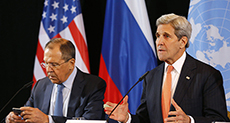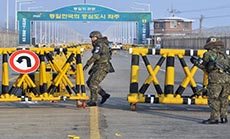Turning point: “Israeli” air attack flips global press coverage of Hizbullah-“Israel” War
Source: Newswise, 1-8-2007
This week marks the one-year commemoration of the "Israeli" air strike on the Lebanese village of Qana, the pivotal moment of last summer's Hizbullah-"Israel" war. The Qana attack left 27 civilians dead and changed world opinion on the conflict. It also flipped global press coverage of Hizbullah and "Israel", according to a new study released Tuesday from the University of Maryland.
The study found that the Qana attack on July 30 was the pivotal event in shifting media coverage of the conflict. "Following the ‘Israeli' attack on the Lebanese town, the press became less critical of Hizbullah and more neutral over all. This was the ‘Qana-effect' on news," noted the study's project director Jad Melki, a visiting journalism professor at Towson University and the research director of the International Center for Media and the Public Agenda (ICMPA) at the University of Maryland, which conducted the study.
Despite Hizbullah's killing of 12 "Israeli" reservists in Kfar Giladi following "Israel's" attack on Qana, coverage of Hizbullah remained more favorable. "That's not to say, however, that the press viewed Hizbullah more favorably than it did ‘Israel'," noted Prof. Susan Moeller, the study's supervisor and the director of ICMPA.
"Hizbullah rarely received any directly sympathetic coverage-and while ‘Israel's' sympathetic coverage fluctuated throughout the war, it never dipped below Hizbullah`s. But at the start of the conflict, ‘Israel' received much more positive coverage than Hizbullah and by the end of the war the level of criticism was almost at the same level."
Three other events registered as significant in the coverage: August 12, the day the UN Security Council adopted resolution 1701; July 20, a day of unprecedented violence and bloodshed on both sides; and July 25, the day following an "Israeli" air strike that killed three UN peacekeepers in south Lebanon. Four out of the five events impacted the coverage in a way that worked against "Israel" and in Lebanon's and Hizbullah's favor. "By the end of the war in mid-August, the press declared Hizbullah the winner of the war," Melki said.
ICMPA's study looked at 14 major English-language newspapers from around the world: The Daily Star (Lebanon), Financial Times (UK), Herald Sun (Australia), Irish Times, Jerusalem Post ("Israel"), Los Angeles Times, Press Trust (India), South China Morning Press, The Guardian (UK), New York Times, The Independent (UK), The Nation (Pakistan), Turkish Daily and the Washington Post
The study tracked their coverage over time, and additionally ranked them according to authority, depth, source balance, frame balance and empathy.
Overall, the coverage was surprisingly even-handed: one-fifth of the articles analyzed were reported from Lebanon, and another one-fifth were reported from "Israel"; 46 percent of the articles were critical of "Israel", and 51 percent were critical of Hizbullah.
Which were the best? The Washington Post, The Guardian and the Irish Times.
Which were the worst? Perhaps no surprise, The Daily Star (Lebanon), the Jerusalem Post ("Israel") and the Turkish Daily-all from the region, and all limited either literally or politically on their ability to station correspondents on both sides of the conflict.
The Washington Post, the Financial Times and the Nation (Pakistan) received the highest scores for balance. The Financial Times scored best on authority (was the coverage first-hand and from the front lines?), and the New York Times had the greatest depth of coverage.
Other findings?
* Although one out of every five articles mentioned a death toll or listed the number of injured, over 90 percent failed to identify the casualties on both sides of the conflict even by name, gender or age. The dead and wounded were mere statistics. The papers that had the most empathetic coverage of the victims were the Washington Post, the Los Angeles Times and the Daily Star.
* Coverage of the fighting and diplomacy dominated the news. Over half of the coverage focused on military operations, international diplomacy and the UN's efforts.
* The economic and environmental consequences of the war received minimal coverage. Stories about economic damage and hardship received less than 2 percent of the coverage, while stories about environmental damage were only 1 percent of the coverage.
* About one in every four of the hundreds of articles investigated in the study included references to terrorism-almost always associated with Hizbullah. But after Qana those references decreased.
* Among the other countries linked to the conflict, Iran received the most critical coverage, followed by Syria, the United States and the UK.
This study on media coverage of war is the most recent report released by the International Center for Media and the Public Agenda (ICMPA), a center of the Philip Merrill College of Journalism and the School of Public Policy at the University of Maryland, College Park.
The study is available online at http://www.icmpa.umd.edu

Kerry to Hold Fresh Talks with Russia on Syria
8 years ago
All but 4 Nations are Subject to NSA’s Espionage
10 years ago
Koreas Agree to Re-open Kaesong Industrial Zone
11 years ago
